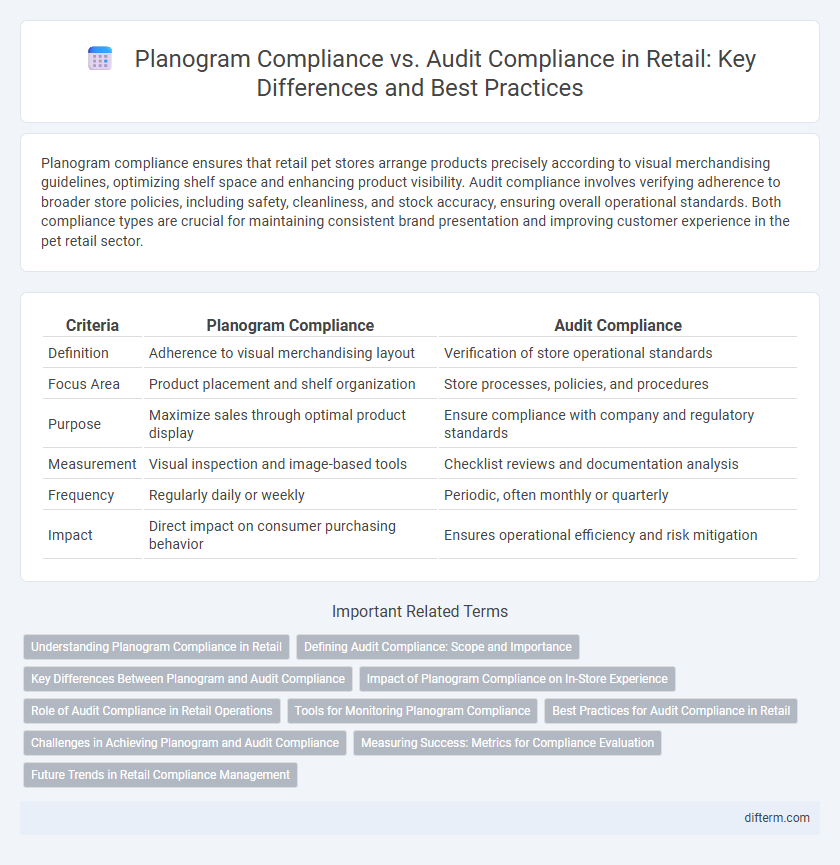Planogram compliance ensures that retail pet stores arrange products precisely according to visual merchandising guidelines, optimizing shelf space and enhancing product visibility. Audit compliance involves verifying adherence to broader store policies, including safety, cleanliness, and stock accuracy, ensuring overall operational standards. Both compliance types are crucial for maintaining consistent brand presentation and improving customer experience in the pet retail sector.
Table of Comparison
| Criteria | Planogram Compliance | Audit Compliance |
|---|---|---|
| Definition | Adherence to visual merchandising layout | Verification of store operational standards |
| Focus Area | Product placement and shelf organization | Store processes, policies, and procedures |
| Purpose | Maximize sales through optimal product display | Ensure compliance with company and regulatory standards |
| Measurement | Visual inspection and image-based tools | Checklist reviews and documentation analysis |
| Frequency | Regularly daily or weekly | Periodic, often monthly or quarterly |
| Impact | Direct impact on consumer purchasing behavior | Ensures operational efficiency and risk mitigation |
Understanding Planogram Compliance in Retail
Planogram compliance in retail refers to the adherence to a predetermined visual merchandising layout, ensuring products are displayed according to specific guidelines to maximize sales and enhance customer experience. Audit compliance evaluates the broader store-level adherence to operational standards, including planogram execution, inventory accuracy, and pricing. Understanding planogram compliance enables retailers to optimize shelf space, improve inventory management, and drive consistent brand presentation across multiple locations.
Defining Audit Compliance: Scope and Importance
Audit compliance in retail refers to the adherence to established standards and procedures during store inspections to ensure accurate merchandising, pricing, and inventory management. It encompasses a broader scope than planogram compliance, including regulatory requirements, operational processes, and financial accuracy. Maintaining rigorous audit compliance helps retailers identify discrepancies, minimize shrinkage, and enhance overall store performance.
Key Differences Between Planogram and Audit Compliance
Planogram compliance measures how accurately products are displayed according to a predefined layout to optimize visual merchandising and sales, while audit compliance evaluates adherence to broader operational standards, including pricing, inventory, and cleanliness. Planogram compliance focuses on product placement and shelf organization, directly impacting shopper experience, whereas audit compliance encompasses a wider range of store policies and regulatory requirements. Retailers rely on planogram compliance for strategic merchandising effectiveness, whereas audit compliance ensures overall store performance and regulatory alignment.
Impact of Planogram Compliance on In-Store Experience
Planogram compliance directly influences the visual merchandising strategy, ensuring products are displayed according to predefined layouts that enhance shopper navigation and product visibility. High planogram adherence optimizes shelf space utilization, reduces out-of-stock instances, and supports inventory accuracy, leading to improved customer satisfaction. Retail audits measuring compliance help identify gaps, enabling targeted corrections that enhance the overall in-store shopping environment.
Role of Audit Compliance in Retail Operations
Audit compliance in retail operations ensures accurate adherence to merchandise placement and inventory standards, directly supporting effective planogram compliance. It provides systematic verification of product displays, pricing accuracy, and shelf organization, which drives sales optimization and enhances customer experience. Consistent audit compliance mitigates shrinkage, improves stock management, and fosters alignment with corporate merchandising strategies.
Tools for Monitoring Planogram Compliance
Effective tools for monitoring planogram compliance include digital shelf-scanning devices, mobile planogram apps, and AI-driven image recognition software. These technologies enable real-time auditing by automatically comparing store shelves against the approved product layouts, enhancing accuracy and efficiency in retail environments. Leveraging cloud-based platforms allows retailers to track compliance trends and generate actionable reports, optimizing merchandising strategies and improving overall audit performance.
Best Practices for Audit Compliance in Retail
Effective audit compliance in retail hinges on continuous monitoring of store adherence to planogram guidelines, ensuring product placement aligns with sales strategies. Implementing digital planogram tools and real-time compliance tracking enhances accuracy and accountability across store locations. Training staff on the importance of planogram adherence fosters consistent execution, directly impacting inventory management and promotional effectiveness.
Challenges in Achieving Planogram and Audit Compliance
Challenges in achieving planogram and audit compliance in retail often stem from inconsistent merchandising execution and limited staff training. Discrepancies between actual shelf layouts and prescribed planograms lead to inventory inaccuracies and poor customer experience. Maintaining real-time accuracy during audits requires robust technology integration and continuous monitoring to minimize human error and operational disruptions.
Measuring Success: Metrics for Compliance Evaluation
Measuring planogram compliance involves tracking product placement accuracy and shelf layout adherence to optimize in-store merchandising effectiveness. Audit compliance metrics focus on broader operational standards such as inventory accuracy, pricing correctness, and promotional execution consistency. Combining both metrics provides a comprehensive view of retail performance, ensuring both visual presentation and operational standards meet brand expectations.
Future Trends in Retail Compliance Management
Planogram compliance ensures that product placements adhere to retailer specifications to maximize sales and customer experience, while audit compliance verifies adherence to broader regulatory and operational standards. Future trends in retail compliance management are leveraging AI-driven analytics and real-time monitoring systems to enhance accuracy and reduce manual errors. Integration of IoT devices and mobile compliance apps is expected to streamline data collection and facilitate proactive issue resolution in retail environments.
planogram compliance vs audit compliance Infographic

 difterm.com
difterm.com